Or search by topic
Number and algebra
Geometry and measure
Probability and statistics
Working mathematically
Advanced mathematics
For younger learners
Published 2021
Counting Collections in the Early Years
This article is a summary of a report that was first published in the Association of Teachers of Mathematics journal 'Mathematics Teaching' in February 2021
Early counting
Families recognise how important it is for children to be able to count but we know that learning to count is complex and takes time. Children need to count regularly and in a range of contexts. There are frequent opportunities for children to count during their day, using verbal counting (saying or singing the counting sequence) and object counting (counting to find how many) as they go about their everyday activities. These are hugely valuable and meaningful counting experiences but, alongside these, moments where children deliberately focus on counting and attend to how to count are important too. They allow children to spend time playing with counting, experimenting with ways to count and to wallow in counting as an enjoyable activity. In this article we explore one such approach, counting collections, detailing how practitioners might develop this approach for use with 2 to 5 year old children (see also the NRICH activity Counting Collections). The examples are drawn from our project work with twenty-one early years settings.
The counting collections approach
The collaborative counting of sets of objects is currently promoted in classrooms in the United States and New Zealand with older children. These counting collections sessions follow a teacher-led, carefully sequenced structure. Children work in pairs to plan, count and record their shared counting of collections of objects (Schwerdtfeger & Chan 2007). The teacher observes and interacts with the children as they engage in paired discussion, counting and representing the structure of their count on paper. The teacher then draws the class together, choosing selected examples of children’s counting strategies to share with the class, perhaps modelling a specific approach.
Resources for counting collections in the early years
Counting collections are containers (boxes, jars or bags) with differing numbers of items within them, depending on the children. Some settings organise the collections into number ranges so the pink collections are 0-5, blue are 6-10, green are 10-20, and so on. It is important to have at least one zero collection and some larger collections too, even if these are fewer when working with the youngest children. The objects should be varied with many collections containing non-identical items to support development of the abstraction principle (as described by Gelman & Gallistel, 1978) so children realise they can count like and unlike items as one set. Some items, such as toy cars or balls, work less well because they can distract children from counting.

Alongside the collections, there are tools which the children may select to help them with their count. Bowls, dishes, pots, bags, mats, five and ten frames can be used to move objects into or out of when counting or opportunities to create groups for counting (e.g. ‘in 3s’ or ‘10 and 5 more’). Wooden and tactile numerals or writing equipment help children label counted collections.
Counting collections can also be used outdoors using buckets as containers. With these larger outdoor collections, children are able to use features of the outdoor environment such as walls or grass verges to line up their items to count or as a space to count their items into. They can transport collections around the outdoor area by carrying the buckets or taking them for journeys on their ride-on vehicles.

List of possible counting collections and tools
An important aspect is the everyday availability of the collections and tools so that children freely access them throughout the day as part of the continuous provision. They can choose to play, pattern and count with the collections during their child-initiated play, expressing and expanding their mathematical interests.
It works well for children to create their own collections in addition to those provided by adults. They can then choose to count each other’s collections and can change the number of items in their collection over time. Families can be provided with bags, jars or boxes to create collections at home. Counting collections is also a lovely activity to do with parents invited into the setting where children engage in paired counting with their parent.
Counting collections sessions in early years
Counting collections sessions follow a general structure where children work in pairs to:
- Choose a collection
- Plan how they will count
- Count the collection
- Record the count
The structure needs to be appropriate to the children. A session can be very fluid with a practitioner working with two children to count and draw. Equally, a session might be more structured with the practitioner leading four clear sections with a whole class. The important thing is that children talk and communicate as they count. Working in pairs helps with this. The children often count the collection more than once as there is often some recounting to check the total, providing additional counting practice as well as supporting accuracy.
Roman and Maya’s Reception class are engaged in a counting collections session. They choose the box of corks from the shelf of counting collections. Maya gets a bowl and Roman places one cork into it at a time. He counts each cork as it is moved into the bowl but miscounts. He empties the bowl and starts again. Maya counts with him this time and they count 10 corks. Roman looks up and states “There’s 10 in the bowl”, Maya nods “ten”. They agree to count them again and this time Maya puts them in a line on the floor. They count to 8 but then the next cork rolls away and Roman has to retrieve it. Maya continues from 8, where she still has her finger poised, and they count together “9, 10”.
Counting the collection
Counting collections support young children to develop one-to-one correspondence, giving one number word to one object when counting. Having pots, tray and bags to count into can help children to move one item at a time, knowing that all the objects counted so far are in the container. Small containers, such as muffin cases, can be used to hold just one item each helping younger children to match one object to one container before counting.
Abbie, choosing to count with her toy dog, used upturned clear plastic shot glasses to cover the wooden cubes in her collection. She then lifted each glass one by one high in the air, shouting the numbers as she counted each cube. This deliberate physical activity clearly separated the counting words and attributed one number word to each item.
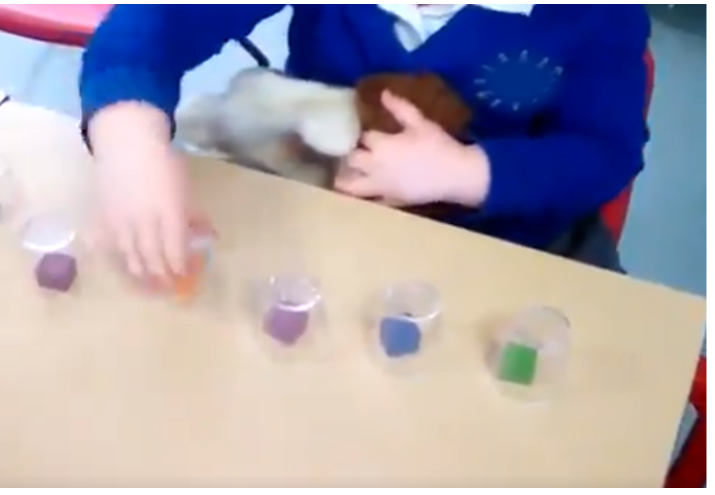
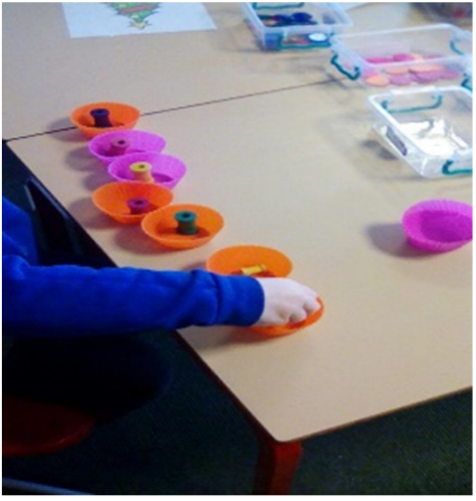
One-to-one correspondence can also be developed through drawing around the items in a collection when recording the count. As children’s counting develops, they might use containers or perhaps 5 or 10 frames for counting. They can count out 5 or 10 and then the remaining objects, emphasising the ‘5 and some more’ and ‘ten and some more’ relationships.
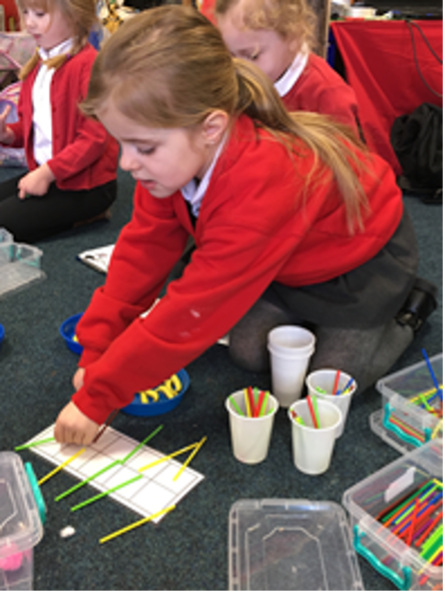 Older children enjoy counting in unitised groups. They might create groups of 2, 3, 5 or 10, containers or frames. In some of the Reception classes that we worked with, pairs of children continued to fill ten frames until all of
their objects were placed, using multiple frames. Others used one frame as a way of creating units of ten, collecting up the ten and settling them in another container safe in the knowledge that the container held ten items. Some practitioners noticed children predicting how many units there would be in their collection. For example, Sarah noted:
Older children enjoy counting in unitised groups. They might create groups of 2, 3, 5 or 10, containers or frames. In some of the Reception classes that we worked with, pairs of children continued to fill ten frames until all of
their objects were placed, using multiple frames. Others used one frame as a way of creating units of ten, collecting up the ten and settling them in another container safe in the knowledge that the container held ten items. Some practitioners noticed children predicting how many units there would be in their collection. For example, Sarah noted:
“One child estimated how many ten frames they would need before they started counting 34 buttons. They got three and were delighted when they were all filled up and they had to go and get another one!”
Recording the count
It is important that children’s recording is their own and that how they represent the collection graphically is left open-ended. This ensures that the children feel ownership of the mathematics, making their own decisions over how to record (further developing mathematical thinking), and making their thinking visible to practitioners. Children’s own recording is rich and varied and can include (as described by Carruthers & Worthington, 2005):
- Pictographic representations which capture something of the appearance of what is in front of the child
- Iconic representations which record one mark (of the child’s own devising) for one object
- Dynamic representations which are suggestive of action
- Symbolic representations which begin to incorporate standard forms of numerals
Children need to see adults using these different forms of representations to know that these are valued and are ways to be mathematical. In the settings we worked with, the practitioners made a conscious effort to use more iconic representations, in particular.
Working in pairs, children make shared decisions about how to record their count. The process of recording provides additional counting and organisation opportunities. Some children prefer to record as they count (for example by drawing around items). Some children (particularly if they have seen an adult modelling this) might use an iconic style of recording, using circles or lines to represent plastic fish, spoons or toy cars, for example.
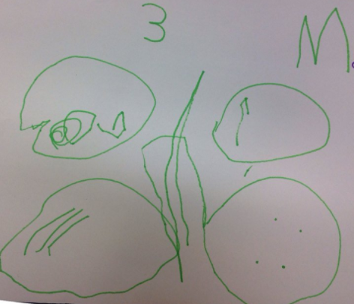 Macey, a three-year old, recorded her count in an increasingly efficient iconic style, along with her partner, four-year old Eva. They had counted their collection of ten objects in groups of three, using dishes. Having
created three groups of three, they discussed what to do with the remaining one item. Macey and Eva initially made one group a group of four, but then moved that final item to create an additional group of one. They recorded this change on a large sheet of paper with two groups of three (left), a group of four (bottom right) then a long line to show the dynamic movement of one object
(middle) into the group of one (top right). The practitioner prompted Macey to record the groups they were counting in and Macey frowned for a moment before writing ‘M’ (top right). When the practitioner looked quizzically at her, Macey exclaimed “I’m three!”. She had apparently used her name as her symbol for ‘3’. Eva looked and exclaimed, “I can’t, I’m four!”
Macey, a three-year old, recorded her count in an increasingly efficient iconic style, along with her partner, four-year old Eva. They had counted their collection of ten objects in groups of three, using dishes. Having
created three groups of three, they discussed what to do with the remaining one item. Macey and Eva initially made one group a group of four, but then moved that final item to create an additional group of one. They recorded this change on a large sheet of paper with two groups of three (left), a group of four (bottom right) then a long line to show the dynamic movement of one object
(middle) into the group of one (top right). The practitioner prompted Macey to record the groups they were counting in and Macey frowned for a moment before writing ‘M’ (top right). When the practitioner looked quizzically at her, Macey exclaimed “I’m three!”. She had apparently used her name as her symbol for ‘3’. Eva looked and exclaimed, “I can’t, I’m four!”
Through storing counting objects as collections (sets), children seemed more confident with attributing a number to a collection (typically using numerals), focussing attention on the cardinality (how many-ness) of the set. Children can collect numerals or number cards to label collections or can use dry-wipe pens (on a plastic lid) or sticky notes to write the number for themselves.
The impact of using counting collections
Using counting collections increases the frequency of counting, range of strategies for counting and the amount of communication of counting (oral and recorded). As Rachel, a Reception class teacher, explained:
“My class now really enjoy counting and have the confidence to talk to others about it”.
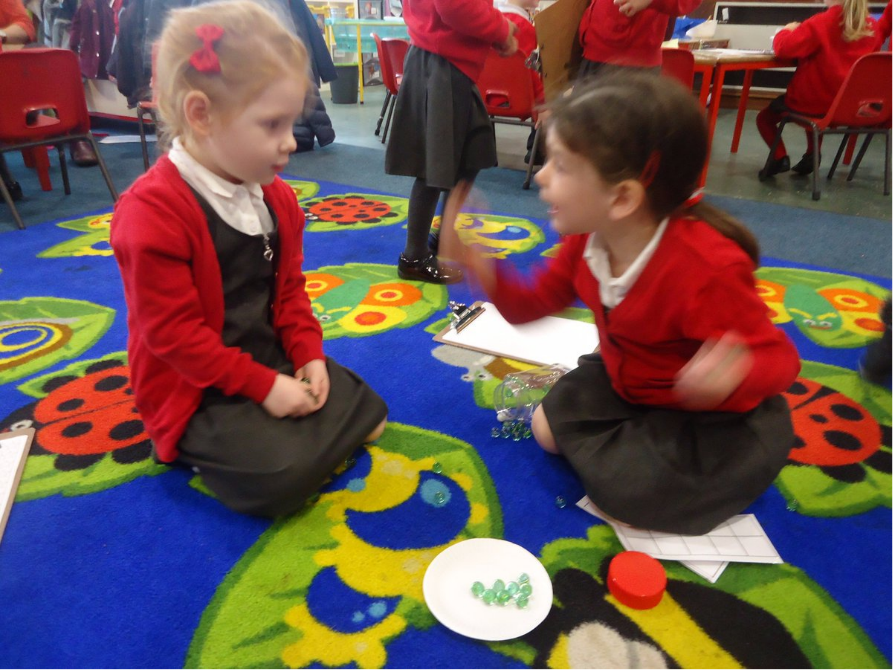
The paired activity seems to slow down the act of counting. It makes counting actions more deliberate and overt, supporting accuracy. Cooperative counting provides young children with ‘a heightened awareness of the need to keep track of one’s counting acts’ (Wiegel 1998: 222). Keeping track is more explicit as a shared endeavour. There are greater opportunities for error spotting and self-checking with mathematical thinking communicated through both manipulation of the objects, and articulation of strategy and reasoning. It also enables children to learn how to count from each other.
Slowing down the counting process and exposing children’s thinking through collaborative activity helps us, as practitioners, to assess children’s counting. It provides the opportunity for us to pinpoint the specific aspects of counting or counting principles that each child seems secure with and which are emerging. We can observe and listen in on children’s counting as well as initiate purposeful conversations about counting. This is evident in Leah and Alfie’s counting in 3s. The recording enables us to assess the accuracy of their counting and also to recognise that the counting has been in ones, despite the grouping in threes (because they would have put the group of two last or miscounted it as a group of three when skip counting). The physical organisation of the count, the dialogue between the two, and the recording, together support the practitioner in identifying appropriate next steps in learning.
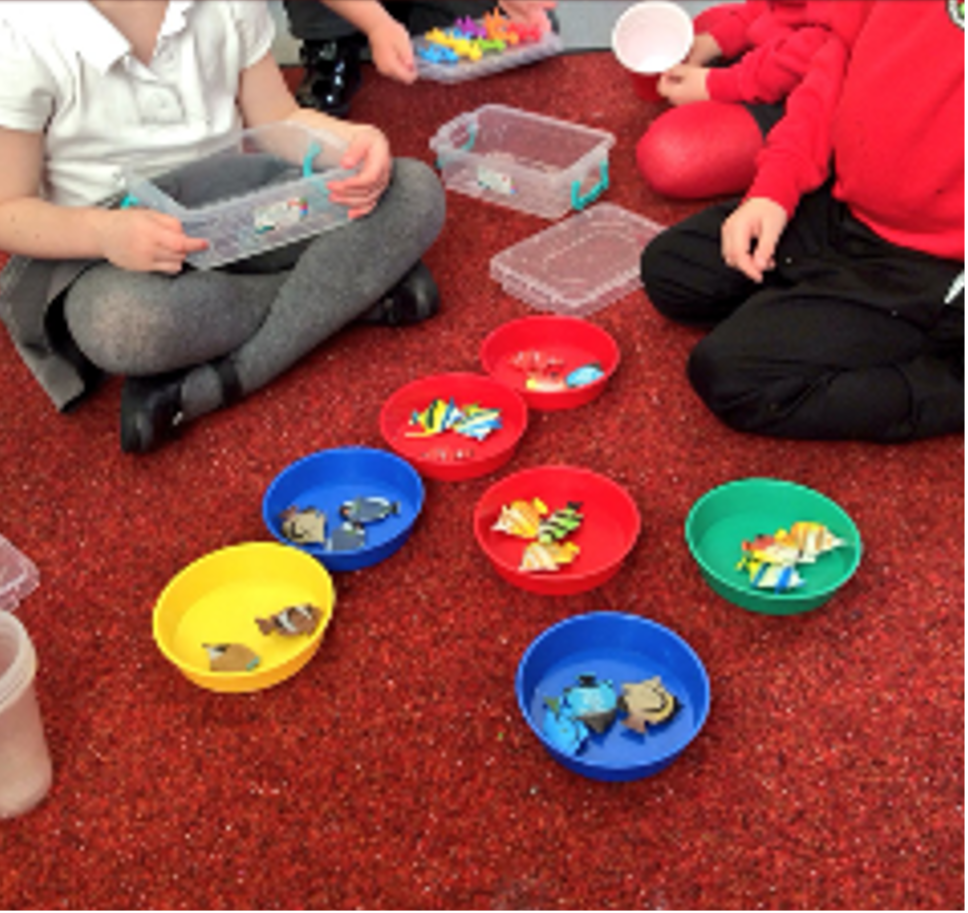
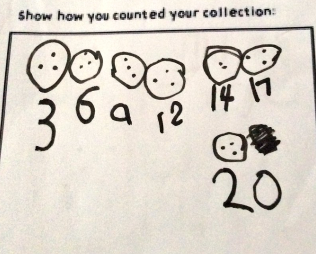
In counting collections, children express preferences about the collections, identifying their favourite ones to count. Having a range of different types of objects in the collections is important as some children like to count long objects which they enjoy lining up, some prefer round objects, and some enjoyed larger objects to cover a space. Fuson, Clements and Sarama (2015) explained that repeatedly counting collections of objects is interesting to young children in the same way that they enjoy repeatedly reading a familiar story. Children have favourite stories and favourite counting collections which are comforting and enjoyable to return to again and again, each time rehearsing the familiar alongside attending to previously unnoticed features.
One of the most important things that practitioners and children say about the counting collections approach relates to the pure joy of counting. Clara explained the effect in her Reception classroom:
“Children are excited about counting and show enthusiasm. They are engaged and asking to count!”
The collections gave children something to talk with, something to talk about and someone to talk to…
“Are we doing counting today? I love it” (Jacob, age 4).
Dr Catherine Gripton is an Assistant Professor in primary education at the University of Nottingham. Deliah Pawluch is a Senior lecturer in primary education at Nottingham Trent University.
This project was funded by East Midlands West maths hub. The work was part of a larger research project into children’s mathematical agency in early years.
References
Carruthers, E. & Worthington, M. (2005) Making Sense of Mathematical Graphics: The Development of Understanding Abstract Symbolism. European Early Childhood Educational Research Journal, Vol. 13(1), 57-79.
Fuson, K.C., Clements, D.H. and Sarama, J. (2015). Making early math education work for all children. Phi Delta Kappan, 97 (3), 63-68.
Gelman, R. & Gallistel, C. (1978) The Child's Understanding of Number. Cambridge, MA. Harvard University Press
Schwerdtfeger, J.K. & Chan, A. (2007). Counting Collections. Teaching Children Mathematics, 13 (7), 356-361.
Wiegel, H.G. (1998). Kindergarten students' organization of counting in joint counting tasks and the emergence of cooperation. Journal for Research in Mathematics Education, 202-224.
Further information about counting collections:
DREME TE (2020) Supporting the development of representation. https://prek-math-te.stanford.edu/counting/classroom-videos-counting
Franke, M.L., Kazemi, E., & Turrou, A.C. (Eds.). (2018). Choral Counting and Counting Collections: Transforming the PreK-5 Math Classroom. New Hampshire: Stenhouse Publishers.
Teacher Education by Design (TEDD) (2014) Counting Collections. https://tedd.org/counting-collections/

